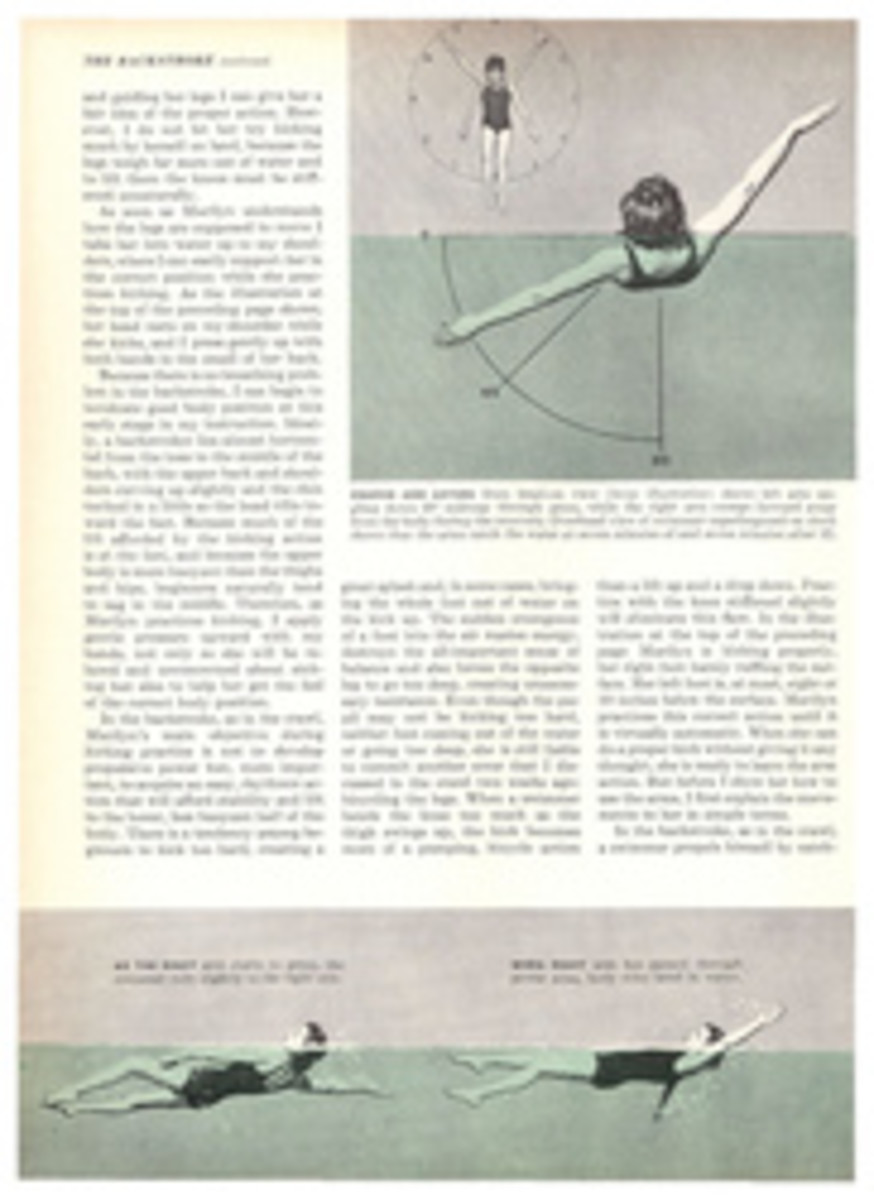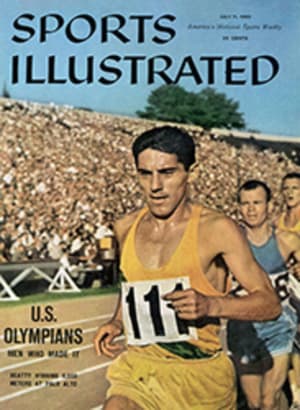
THE BACKSTROKE
Though the crawl will serve adequately in most situations, there is a very good reason why everyone entering the world of water sports today should learn two other basic strokes—the backstroke and the breaststroke. In the water, versatility means durability. All three strokes use just about every muscle in the body, but each uses the muscles somewhat differently. Thus, by switching from one stroke to another, a versatile swimmer can relieve his muscles—in a sense, rest a bit—while he keeps moving through the water.
Because it is essentially a crawl swum on the back, the backstroke, demonstrated on these pages, is logically the second stroke to teach a child. In fact, often when I am giving a youngster regular instructions—say, three or more lessons a week—I will relieve the routine of practice by starting in on the backstroke even before the pupil is competent enough to go it alone in the crawl.
My granddaughter Marilyn, who served as a model pupil for the crawl, again this week helps me demonstrate my methods for teaching the backstroke. There being no appreciable difference between sexes when learning any stroke, naturally my advice applies equally if your pupil is a boy.
In one respect the backstroke is simpler than the crawl. Because the face is above water at all times, breathing is no problem; the pupil needs only to coordinate two important actions, the kick and arm stroke.
In the backstroke, as in the crawl, I teach the kick first, then add the arm movements to it. The action of the backstroke kick, like that of the crawl kick, emanates from the hips, one leg lifting up as the other drops down. The feet should be limp at all times, as limp as can be. The knees should be fairly relaxed, so that each leg flexes slightly and naturally at the knee on the kick up but is quite straight on the drop down.
To introduce Marilyn to the kick I first take her into foot-deep water. There, by sitting down and leaning back, supporting her upper body on her elbows, she can start trying the leg action slowly and easily. If there were no shallows suitable for this preliminary practice, I would have Marilyn recline in the same fashion on land. By taking her feet in my hands and guiding her legs I can give her a fair idea of the proper action. However, I do not let her try kicking much by herself on land, because the legs weigh far more out of water and to lift them the knees must be stiffened unnaturally.
As soon as Marilyn understands how the legs are supposed to move I take her into water up to my shoulders, where I can easily support her in the correct position while she practices kicking. As the illustration at the top of the preceding page shows, her head rests on my shoulder while she kicks, and I press gently up with both hands in the small of her back.
Because there is no breathing problem in the backstroke, I can begin to inculcate good body position at this early stage in my instruction. Ideally, a backstroker lies almost horizontal from the toes to the middle of the back, with the upper back and shoulders curving up slightly and the chin tucked in a little so the head tilts toward the feet. Because much of the lift afforded by the kicking action is at the feet, and because the upper body is more buoyant than the thighs and hips, beginners naturally tend to sag in the middle. Therefore, as Marilyn practices kicking, I apply gentle pressure upward with my hands, not only so she will be relaxed and unconcerned about sinking but also to help her get the feel of the correct body position.
In the backstroke, as in the crawl, Marilyn's main objective during kicking practice is not to develop propulsive power but, more important, to acquire an easy, rhythmic action that will afford stability and lift to the lower, less buoyant half of the body. There is a tendency among beginners to kick too hard, creating a great splash and, in some cases, bringing the whole foot out of water on the kick up. The sudden emergence of a foot into the air wastes energy, destroys the all-important sense of balance and also forces the opposite leg to go too deep, creating unnecessary resistance. Even though the pupil may not be kicking too hard, neither foot coming out of the water or going too deep, she is still liable to commit another error that I discussed in the crawl two weeks ago: bicycling the legs. When a swimmer bends the knee too much as the thigh swings up, the kick becomes more of a pumping, bicycle action than a lift up and a drop down. Practice with the knee stiffened slightly will eliminate this flaw. In the illustration at the top of the preceding page Marilyn is kicking properly, her right foot barely ruffling the surface. Her left foot is, at most, eight or 10 inches below the surface. Marilyn practices this correct action until it is virtually automatic. When she can do a proper kick without giving it any thought, she is ready to learn the arm action. But before I show her how to use the arms, I first explain the movements to her in simple terms.
In the backstroke, as in the crawl, a swimmer propels himself by catching and pressing the water with one arm while recovering the other out over the water. Because of the design of the human body, a swimmer lying on his back in the water cannot easily catch the water straight ahead. If you superimposed a typical backstroker on the face of a clock, as in the smaller of the two illustrations at left, the swimmer's right hand would catch the water at about seven minutes to 12 and the left hand at seven minutes after. In the larger illustration and in the sequence of Marilyn backstroking at the bottom of the page, you can see that from the catch through the press underwater until the hand ends up alongside the upper thigh the arm does not travel in a shallow plane, but rather, it arcs downward like a row-boat oar, angling about 30° below the horizontal at the deepest point, halfway through the arc.
During the catch, press and recovery, the hand should be kept straight in line with the forearm, fingers together but not tense. As each hand catches, the palm is facing slightly upward so that the outside edge of the hand (the edge along the little finger) enters first. Underwater, of course, the hand presses squarely against the water.
The beginner should start pressing easily from the moment of the catch and keep pressing until the arm passes through the mid-point of the arc. This is the area of maximum power, when the hand is pressing at right angles to the swimmer's line of travel. Once past the mid-point, the pressure should be eased off so that at the very end of the stroke the arm almost drifts up alongside the body. To get the most out of each stroke, some good backstrokers keep pressing through most of the underwater arc until the arm is virtually back at the surface alongside the leg. And a few topnotch racers bend the arm a good bit at the finish in order to give a little extra push before the hand rises from the water. But for the beginner I feel it is best to keep the arm fairly straight throughout the press, with the elbow relaxed so there is only a slight bending as the arm swings back up to the side.
As the hand rises above water to start the recovery, the arm should be straight but, here again, not stiff. If, at the start of the recovery, the hand is vertical, that is, with palm facing in toward the body, the hand will come out of the water most easily. As the arm moves forward through the air, the hand is turned slightly so that the palm faces the feet. With the hand in this position (as you can see by trying it on land), the natural rotation of the shoulder during the recovery will put the outside edge of the hand back into the water first on the next catch. Throughout the recovery, the arm is not lifted vertically but out at an angle, away from the body. This prevents water from sloshing in the face and brings the arms more directly to the entry position at seven minutes of and seven minutes after.
Practicing the stroke
In the backstroke, as in the crawl, the body will roll to the side of the arm that is pressing. This puts the opposite shoulder slightly higher, facilitating recovery of the other arm. With an expert swimmer, this roll is a subtle, easy movement. However, with a beginner I never expect anything near perfection. I am satisfied if the roll is not so excessive that it destroys the rhythm of the stroke or upsets the balance in the water.
After explaining the stroke to Marilyn, for actual practice I take her again into water that comes high on my shoulders. There I support her as I did before while she was kicking. But now, as she kicks, I gradually slip my hands up her back and finally take hold of the backs of her arms just above or just below the elbows. While she continues kicking easily, I guide her arms alternately through the stroke.
If she still seems slightly heavy in the water, to keep her at ease I put a small tube around her waist, inflated just enough to give her natural buoyancy but not so much that she rides unnaturally high in the water.
After guiding Marilyn's arms through the action, I next put my hands under her back so she can practice the movements without any control by me. As she gets the feel of it, I slowly back up, yielding to the increasing strength of her stroke. As both my hands and my eyes tell me that she is gaining confidence in her own buoyancy, I gradually ease off the pressure of my hands on her back. When I can barely feel her weight, I drop my hands away completely.
Once you have your pupil going in this way under her own power, I urge you to remember, above all, that the ability to thrash a dozen strokes without stopping proves nothing. It is better for the beginner to take only two or three good, relaxed strokes, then stop and try three or four more, and slowly develop an easy way of stroking through the water.
ILLUSTRATION
ED VEBELL
PRESSING GENTLY UP WITH HANDS, COACH MATT MANN HOLDS PUPIL IN CORRECT BODY POSITION WHILE SHE PRACTICES KICK
ILLUSTRATION
ED VEBELL
PROPER ARM ACTION from head-on view (large illustration) shows left arm angling down 30° midway through press, while the right arm sweeps forward away from the body during the recovery. Overhead view of swimmer superimposed on clock shows that the arms catch the water at seven minutes of and seven minutes after 12.
ILLUSTRATION
ED VEBELL
AS THE RIGHT arm starts to press, the swimmer rolls slightly to the right side.
ILLUSTRATION
ED VEBELL
WHEN RIGHT arm has passed through power zone, body rides level in water.
ILLUSTRATION
ED VEBELL
AS THE LEFT arm presses, body rolls to left, with right shoulder rising slightly.
ILLUSTRATION
ED VEBELL
WHEN THE LEFT arm slacks off pressure, the right arm is finishing the recovery.
AN OLD, RESTFUL STROKE
Two weeks hence Coach Mann concludes his basic swimming lessons by showing how he teaches the old orthodox breaststroke, a restful and valuable part of any swimmer's repertoire.

